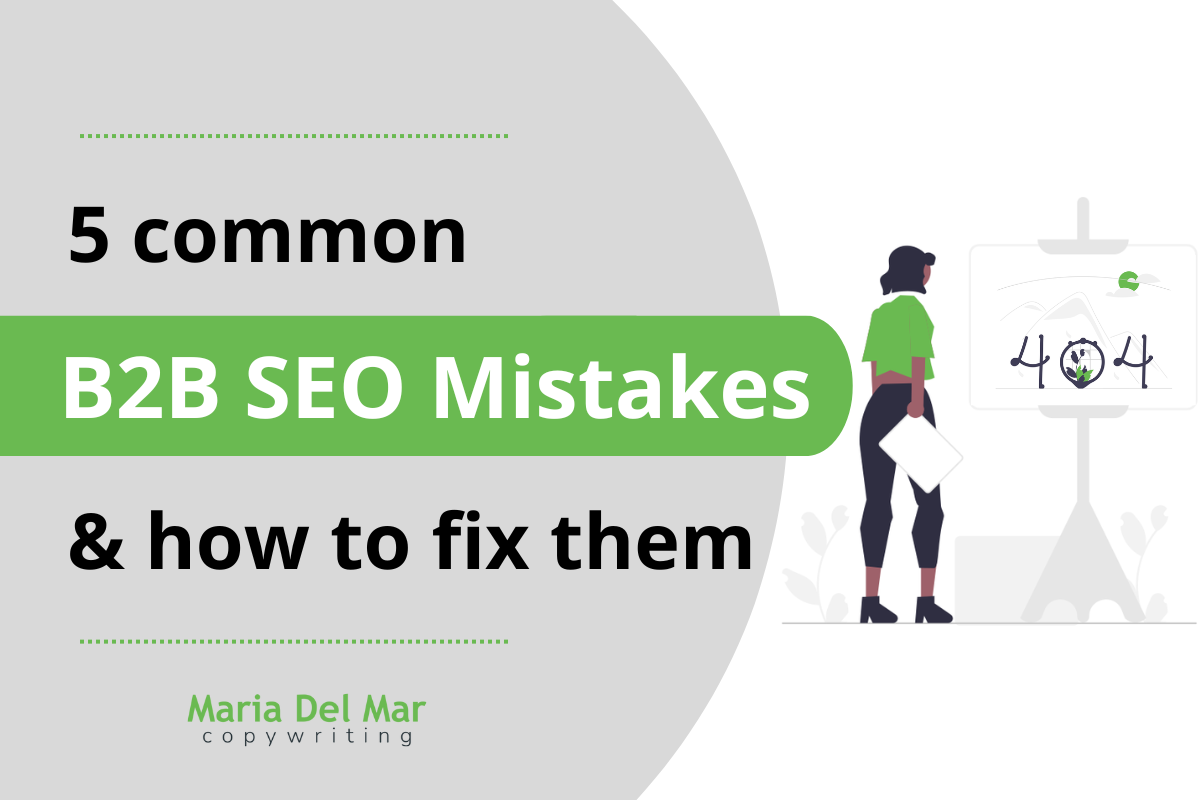According to the 2023 Marketing Mix Report by Sagefrog, SEO leads the way among the most implemented marketing tactics for B2B marketing.
Undoubtedly, SEO (Search Engine Optimization) is a great tool for B2B companies to improve brand visibility and drive more website traffic.
But if you don’t use it correctly, your website won’t appear in the search engines, and your potential clients won’t find solutions to their pain points.
So without further ado, let’s look into 5 common SEO mistakes that can be made that will impact your website’s performance and how to fix them.
1. You aren’t targeting the right customer-relevant keywords

One of the most important B2B SEO mistakes is using irrelevant keywords for your target audience.
If you make the mistake of using general keywords, your B2B customer will never find the particular keyword that is searching and will find another website with the necessary information that they need to solve their problems. This translates into a higher bounce rate, which negatively impacts search engine rankings.
How to fix it?
These strategies can help you find customer-relevant keywords:
- Conduct intensive research focusing on your B2B customer’s pain points, needs, and search behaviours.
- Identify appropriate keywords that your customers use to search and analyze competitors using tools such as Moz, Ahref, and SemRush.
- Understand search intent: Analyze the search intent behind keywords to align them with your business goals.
2. You have a poor internal linking strategy

There’s no doubt that external links greatly impact your search engine rankings. But always, the value of a good internal linking strategy is not taken into account.
Internal links are links that point from one page on your website to another page on your website. It’s an essential part of building a website that’s easy to navigate and defines the hierarchy and page authority throughout your site.
It’s crucial to have a solid internal linking strategy because search engine crawlers can benefit from the clear path networks that internal links produce, and a well-linked website also helps spread its authority.
Moreover, by including relevant, helpful internal links throughout your content, you will improve the user experience and increase the time they spend on your website. Also, you can boost your brand’s reputation and conversions while also delighting search algorithms.
How to fix it?
These actionable tips can help to fix your poor internal strategy:
- Audit your internal links: Start by conducting a thorough audit of your website’s internal linking structure. Identify pages that lack internal links, pages with too many links, and opportunities for better linking.
- Strategic placement: According to most experts, blog posts should include 2 or 3 internal links. The second most common answer is 4 to 5 links. It’s crucial to strategically place these links within your content where they naturally fit and add value to the reader. Don’t overdo it, as too many internal links can appear spammy.
- Anchor text optimization: Don’t neglect your link anchor text; aim to use keywords as anchors for linking to other content that covers that keyword more in-depth. This not only helps users understand what they’ll find when they click but also assists search engines in understanding the context of the linked page.
- Create pillar content and topic clusters: This not only helps users navigate your site but also signals to search engines the structure and importance of your content.
3. You are publishing low-quality content

Content creators always have the same debate when we start to write blogs, and even more so in the AI era.
Quality vs Quantity content
From my point of view, as a B2B content creator, it’s really important to prioritize quality over quantity when it comes to your content creation efforts.
Creating high-quality content that is relevant to your target audience is crucial for generating leads. In fact, high-quality content has been found to generate 9.5 times more leads compared to low-quality content.
How to fix it?
Here are some general steps to follow if you want to fix this B2B SEO mistake:
- Identifying content with low search engine traffic: Optimize underperforming pages by updating content, metadata, and targeting relevant keywords. You can use tools like Google Analytics and Google Search Console to pinpoint pages with minimal organic traffic. Also, you can employ tools like SEMrush or Ahrefs to detect pages with low search traffic and analyze keyword rankings.
- Managing cannibalized content: Merge or redirect competing pages and review internal linking strategies to prevent keyword cannibalization. You can perform site audits with tools like Screaming Frog or Moz to identify pages competing for the same keywords.
- Fixing broken links: Update URLs, redirect to relevant pages, and maintain internal and external links for a seamless user experience and SEO integrity. You can use tools like Screaming Frog, Google Search Console, or Broken Link Checker to identify and fix broken links.
4. You are ignoring technical SEO

Some time ago, content marketers, when we had to do SEO strategies, focused on on-page and off-page SEO and ignored the technical ones.
This was a big mistake.
Technical SEO is essential to any B2B SEO strategy since it immediately improves visibility and performance. In that way, your website will rank higher in search engine results and also provide an excellent user experience to potential clients and partners.
How to fix it?
Follow these best practices to improve your website’s technical SEO to stay ahead of the competition:
- Optimize site speed: Fast-loading websites tend to rank better in search engine results. Compress images, leverage browser caching, minify CSS and JavaScript files, and use a content delivery network (CDN) to improve your site’s speed.
- Mobile-friendly design: Ensure your website is responsive and provides a good user experience across various devices, especially mobile. Google prioritizes mobile-friendly websites in its search results.
- Optimize URL structure: Use descriptive, keyword-rich URLs that are easy for both users and search engines to understand. Avoid dynamic URLs with long strings of characters or parameters.
- Create an XML Sitemap: Generate and submit an XML sitemap to search engines to help them discover and crawl your website’s pages more efficiently.
- Optimize Robots.txt File: Use the robots.txt file to instruct search engine crawlers on which pages to crawl and index and which ones to ignore. Make sure important pages are allowed.
- Fix broken links and 404 errors: Regularly check for broken links and 404 errors on your website, and fix them promptly to avoid negative impacts on user experience and SEO.
- Optimize images: Use descriptive file names and alt attributes for images to help search engines understand what the images are about. Compress images to reduce load times without sacrificing quality.
- Secure your website with HTTPS: Secure your website with HTTPS to encrypt data transmitted between your website and its visitors. Google considers HTTPS as a ranking factor and provides a slight SEO boost to secure websites.
- Optimize Meta Tags: Write compelling and relevant title tags and meta descriptions for each page, including primary keywords where appropriate. Avoid duplicate meta tags across different pages.
5. You aren’t giving your strategy time to take effect

SEO is not a quick fix; it’s a long-term strategy that requires time and consistency to achieve significant results.
When you change your SEO tactics without giving them enough time to produce results, you disrupt the process and hinder potential progress.
Search engine algorithms and human users alike need time to recognize and appreciate the value of your content. This distinction is based on factors like audience engagement, keyword relevance, and overall content quality.
How to fix it?
To avoid one of the most important B2B SEO mistakes , it’s essential to have realistic expectations and give your SEO strategy time to unfold.
While it’s important to monitor performance and make minor adjustments as needed, refrain from making drastic changes too soon.
Also, allow your content to gain traction, analyze audience interaction, and only make significant revisions once you’ve given your strategy ample time to gain momentum.
Remember, successful SEO is a marathon, not a sprint.
Summing up
In conclusion, effective B2B SEO requires vigilance, patience, and strategic adaptation.
If the 5 B2B SEO mistakes highlighted in this article are not fixed, they might greatly impede the smooth functioning of your website.
As an expert SEO copywriter and B2B content marketer, I can help you fix these issues on your website.
Together, we can refine your keyword targeting, optimize your internal linking, improve your content quality, tackle technical SEO issues, and patiently wait for the results.
